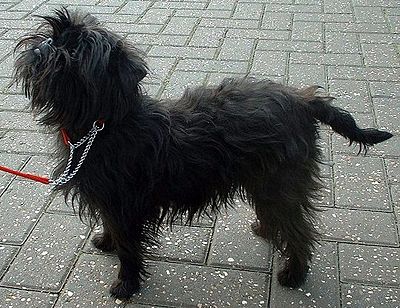
Search
Affenpinscher

The Affenpinscher (German: [ˈafn̩ˌpɪnʃɐ] ) is a German breed of small toy dog of Pinscher type.: 30 Originally developed as a mouser, the Affenpinscher is now commonly found as a companion worldwide.
History
The word 'Affenpinscher' derives from Affe, German for 'ape' or 'monkey'; it is sometimes translated as 'Monkey Terrier', although the dog is a pinscher and not a terrier.: 30
The origins of the Pinscher group of dogs are unknown. Dogs of this type, both rough-haired and smooth-haired, were traditionally kept as carriage dogs or as stable dogs, and so were sometimes known as Stallpinscher; they were capable ratters. Until the late nineteenth century, both rough-haired and smooth-haired types were known as Deutscher Pinscher, and came from the same lineage; puppies of both types could occur in the same litter.
In 1880 the Pinscher was recorded in the Deutschen Hundestammbuch of the Verein zur Veredelung der Hunderassen. In 1895 Ludwig Beckmann described five varieties of Pinscher – the rough- and smooth-haired Pinscher, the rough- and smooth-haired Miniature Pinscher, and the Affenpinscher.: 152 In 1895 a breed society, the Pinscher-Schnauzer-Klub, was established for both types, both rough- and smooth-haired.
Dogs of the Affenpinscher type have been known since about 1600. There were originally thought to be two sizes, the larger size is now extinct.: 30 The larger size was approximately 30 to 33 centimetres (12 to 13 in), and came in colors of grey, fawn, black, tan, and red. White feet and chests were also common. The breed was created to be a ratter in homes, working to remove rodents from kitchens, and also granaries and stables. Early breeders crossed the various schnauzers and pinschers with the goal to create a mouser who also was a good companion dog. Some of the breeds that may have been included to produce the Affenpinscher are pugs, German pinschers, schnauzers and silky pinschers.
The breed predates and is ancestral to the Griffon Bruxellois (Brussels Griffon) and Miniature Schnauzer which was thought to be from affenpinschers crossed with standard schnauzers in addition to other breeds.: 30 The breed was recognized by the AKC in 1935 and the FCI in 1955.
Banana Joe V Tani Kazari, a.k.a. Joe, a five-year-old Affenpinscher, was named Best in Show at the 2013 Westminster Kennel Club Dog Show in New York City.
Description
Appearance
An Affenpinscher generally weighs four to six kilograms (9–13 lb) and stands 25–30 cm (10–12 in) tall at the withers. It has a harsh rough coat when it is not clipped, but if clipped it can be softer and fluffier. It has a notable monkey-like expression (affe is German for monkey). Its coat is shaggier over the head and shoulders, forming a mane, with a shorter coat over the back and hind quarters. It is harsh and wiry in texture when properly maintained. The FCI and British The Kennel Club breed standards specify that the coat must be black, but the American Kennel Club also allows grey, silver, red, black and tan, and beige (a mixture of red, brown, black and white hairs).
Temperament
Affenpinschers have a distinct appearance that some associate with terriers. However, they are part of "Group 2, Section 1: Pinschers and Schnauzers" in the FCI classification, and not the terrier group. They are active, adventurous, curious, and stubborn, but they are also fun-loving and playful. The breed is confident, lively, affectionate towards family members and is also very protective of them.: 30
Affenpinschers are somewhat territorial when it comes to their toys and food, so they are not recommended for homes with very small children. This dog is mostly quiet, but it can become very excited if attacked or threatened and shows no fear toward any aggressor.
Health
A UK study found a life expectancy of 9.3 years for the breed compared to an average of 12.7 for purebreeds and 12 for crossbreeds
The Affenpinscher is prone to hip dysplasia. As with many small breeds of dog, they are prone to collapsed trachea and luxating patella. Some are prone to fractures, PDA, open fontanel and respiratory problems in hot weather. Ocular conditions such as cataracts are occasionally reported. An emerging concern is syringomyelia, although the incidence is currently unknown.
Affenpinscher bitches are more prone to seasonal flank alopecia, which seems to affect them during the winter.
References
Text submitted to CC-BY-SA license. Source: Affenpinscher by Wikipedia (Historical)
Owlapps.net - since 2012 - Les chouettes applications du hibou




